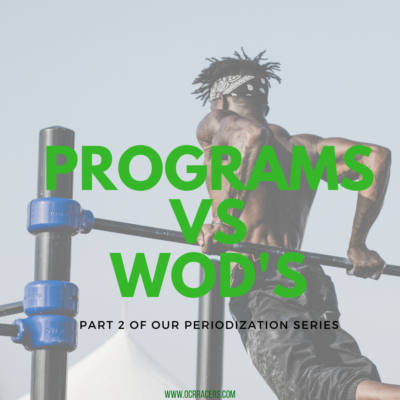This is Part 2 (Programs vs WOD’s) of a 6-Part Series on Periodization.
In this post, I discuss Training Programs vs WOD’s (Workout of the Day’s). And just because I’m saying programs vs WOD’s doesn’t mean you have to choose either/or… evaluate your goals and proceed accordingly.
WHAT IS A WOD?
In essence, WOD’s are exactly what they sound like: a workout of the day. There is no doubt that these are great and can be extremely beneficial for filling in a workout on days you don’t have anything scheduled, you need to change things up, or you’re traveling where things like time, equipment or space (none or lack thereof) limit your ability to follow your normal program. They’re oftentimes fun and get your heart rate up quickly. The travel workouts offered here can even be used as heart-pumping WOD’s when you lack space or equipment.
HOW IS A PROGRAM DIFFERENT?
Programming is a carefully calculated routine, generally consisting of pre-planned workouts for a duration of 6-16 weeks (depending on where you are in your training cycle), and there’s a strategic goal in mind. You want to improve as an athlete? This is where true “programs” take advantage of the known physiological adaptations and timelines.
Basically, your body is not going to improve/make gains without putting an actual program into play. Your body needs time. Your body needs time to heal, as well as time to make the physiological improvements needed to take you to the next level. In proper programming, you will need certain rep ranges to encourage corresponding muscular adaptations. In other words, an athlete’s objectives should vary from person to person because you are each working to achieve different goals, whether it’s becoming an endurance athlete (ultras), short distance specialist (5k’s or stadium series), power lifter, body builder, or whatever other kind of athlete you strive to be. Additionally, certain heart rate zones can encourage corresponding cardiovascular adaptations in order to mimic what “race day” feels like. Think of this as getting your motor constantly tuned up. With the proper program and scheduling, you can also plan for other variables like set schemes, recovery time, and frequency of training.THE MAIN DIFFERENCES:
The main differences between a WOD and a thorough Athlete Training Program is that programming uses both Minimum Effective Volume (“MEV”) and Maximum Recoverable Volume (“MRV”). WOD’s do not.
MEV is the minimum number of working sets that the body must experience in a period of time to make the desired adaptation to the stress you put your body and mind through. MRV is the maximum number of working sets that the body can experience in a period of time and still recover for optimal training without forcing overtraining. In contrast, a WOD offers either an aerobic and/or anaerobic workout, with no thought process going into the long-term athletic aspirations. They instead tend to focus on giving you a one-day workout that is fun, different and a good sweat. If you’re looking for day-to-day workouts, then these suffice. If you’re looking for athletic improvements to achieve long-term goals, then you should be considering a legitimate strength training program.
CAN YOU DO BOTH?
It’s not a bad thing to necessarily incorporate both — so long as you keep your bigger picture in mind. For example, the co-founders of ocrracers.com, Eddie and Bethany, have gone through my strength and conditioning programming for several years now. But, their gym offers a “Strongman Class” once a week. They normally show up for it and participate. They flip tires, pull sleds, or whatever else is on tap for that day. Their workout is fun, they get a great sweat on and get to work out with friends.
So, even though they do a WOD once a week — the other days are dedicated to executing their training program at full speed in order to realize long-term athletic progress. As a result, they have seen huge strides in their times, results, and overall fitness, proving to be invaluable both on and off the race course. Both have become constant contenders for podium spots each time they toe the start line. Whether your goal is to alter the body’s capabilities, seek improvement, or you’re trying to take yourself to that “next level.” keep in mind that programming consistently through consecutive days, weeks, and months should be coordinated for best results. You should be planning for your strength, flexibility and cardio to jive with one another in a strategic pattern in order to achieve optimal performance. Questions? Let me know. I’m a certified strength and conditioning specialist, and I love the science behind successful training programs. As many wise individuals have said: “People don’t plan to fail, they fail to plan.” Learn more about the strength training programs I’ve written to specifically improve the skillsets needed by obstacle course racers out on the course.PRIOR ARTICLES IN THE SERIES:
Part 1 – Periodization: What is it, and Why Does it Matter?
About the Author: Palmer Shape holds a B.S. in Physiology and is a Certified Strength and Conditioning Specialist designation (CSCS). He is equipped with over a decade of competition experience, having coached and trained hundreds of high school, college, and professional athletes, including obstacle course racers. A hurdler by nature, he is no stranger to overcoming obstacles quickly and efficiently. His passion, combined with scientific knowledge and data, have helped hundreds of athletes take their training to the next level, often reaching podium spots or winning coveted titles. You can find him on Instagram: @palmer_shape


